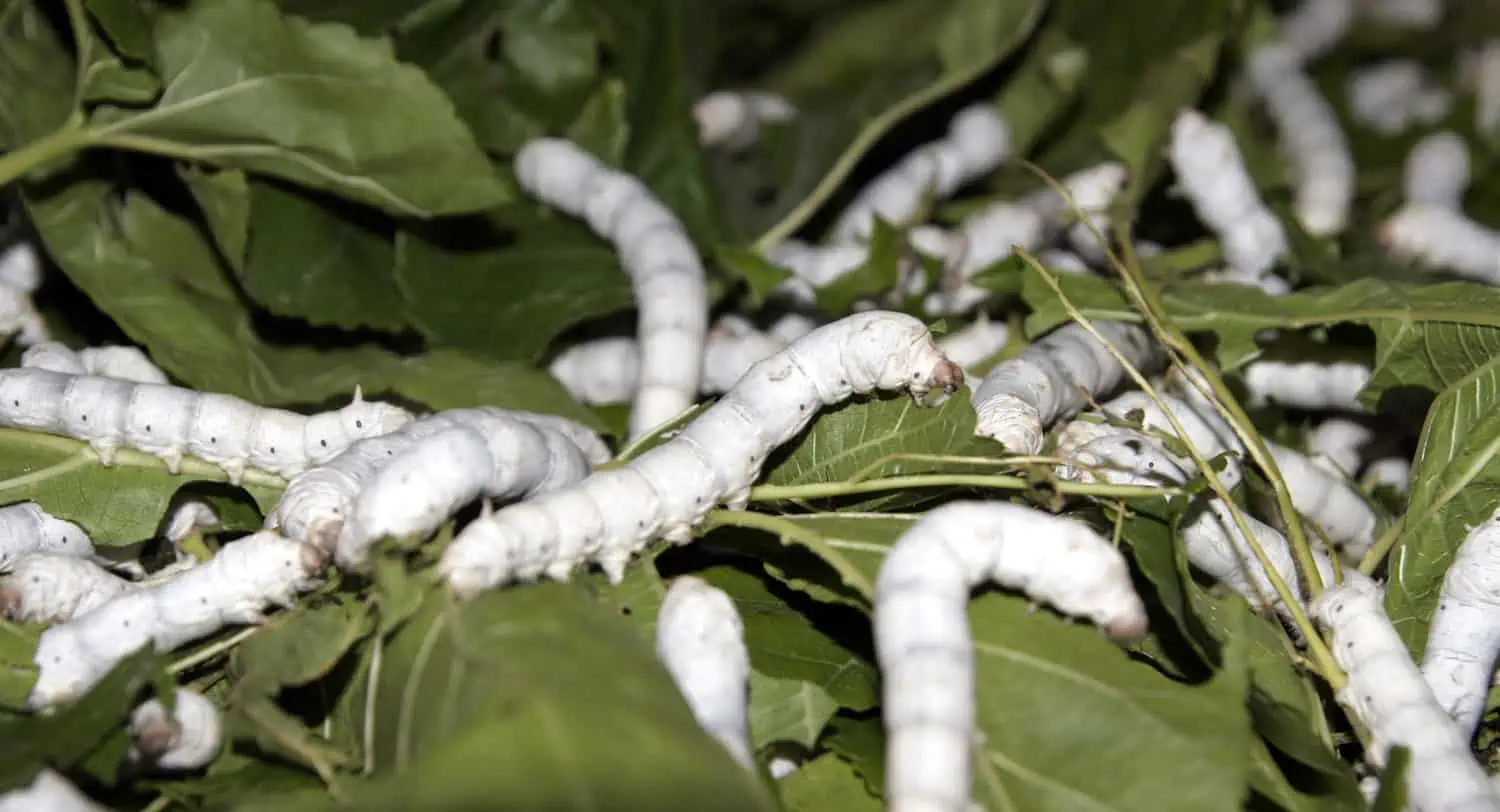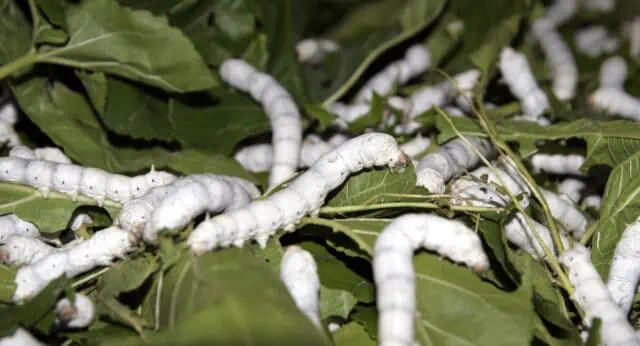Yes, leopard geckos can eat silkworms. Silkworms are not only edible for these reptiles but also offer a good source of nutrition. As a leopard gecko owner or enthusiast, it’s essential to understand the role of silkworms in their diet and how they contribute to the overall health.
Can Leopard Geckos Eat Silkworms?
Absolutely, leopard geckos can and do eat silkworms. These worms serve as a nutritious meal, packed with essential nutrients beneficial for the gecko’s growth and overall health. As we explore the relationship between leopard geckos and silkworms, we’ll uncover the specifics of what makes silkworms a viable food option and the considerations to keep in mind when incorporating them into a gecko’s diet.
What is a Silkworm?
Silkworms, known scientifically as Bombyx mori, are fascinating creatures with a unique place in nature. Their physical characteristics set them apart: these worms are typically whitish or yellowish in color, possessing a soft and smooth texture. Their life cycle is a journey from egg to worm, then from pupa to moth. During the worm stage, they primarily feast on mulberry leaves, giving them their name.
But what makes silkworms especially intriguing is their role in the silk-making process. These worms are the larval stage of Mulberry silkmoths. As they prepare to transition into the pupa stage, silkworms spin protective cocoons around themselves using a special silk-producing gland. This silk is renowned worldwide for its luster, texture, and quality.
Table: Quick Facts About Silkworms
| Fact | Details |
|---|---|
| Color | Whitish or yellowish |
| Diet | Primarily mulberry leaves |
| Stage with silk-producing ability | Larval stage |
| Lifespan of adult moths | Short, typically around 5-10 days after emerging from cocoons |
| Known for | Production of silk |
Nutritional Value of Silkworms as a Food Source for Leopard Geckos
Silkworms aren’t just creators of beautiful silk; they also offer a wealth of nutrition, especially when considered as a food source for leopard geckos. Analyzing the nutritional value of these worms, one finds an impressive composition of moisture, protein, fat, calcium, and phosphorus.
Table: Nutritional Composition of Silkworms
| Nutrient | Value |
|---|---|
| Moisture | High, ensuring hydration |
| Protein | Rich source for muscle growth |
| Fat | Essential for energy and health |
| Calcium | Critical for bone strength |
| Phosphorus | Important for metabolic functions |
For leopard geckos, these nutrients play a crucial role in their overall health and vitality:
Moisture: Ensures that the gecko remains hydrated, aiding in digestion and overall cell function.
Protein: Provides the building blocks for muscle growth, repair, and general maintenance of bodily tissues.
Fat: Offers a necessary source of energy and supports the absorption of certain vitamins.
Calcium: A fundamental mineral, it ensures strong bone development and health.
Phosphorus: Works hand in hand with calcium and plays a vital role in various metabolic functions.
Pros and Cons of Feeding Silkworms to Leopard Geckos
When contemplating whether to incorporate silkworms into a leopard gecko’s diet, it’s essential to weigh the pros and cons to make informed feeding decisions.
Pros
Nutritional Benefits: Silkworms bring a plethora of nutritional benefits to the table. Their high levels of protein, calcium, and other essential nutrients support the optimal health and growth of leopard geckos.
Cons
Housing and Feeding Challenges: Housing silkworms can be quite cumbersome. They have specific dietary needs—primarily mulberry leaves—and require particular conditions to thrive. If their needs are not met, it could lead to the demise of the silkworms before they can be fed to the geckos.
Risk of Diseases: Silkworms can sometimes harbor diseases or parasites, similarly to many other insects (spiders, etc). Feeding infected silkworms to leopard geckos can inadvertently introduce these health issues to the geckos, which may result in illness.
Limited Availability: Depending on the location, obtaining silkworms can be challenging. They are not as readily available as other feeder insects, which can make them a less convenient food option.
Difficulty of Gut Loading: Gut loading—feeding nutritious food to the silkworms to enhance their nutritional value—is crucial but can be challenging due to their specific dietary preferences.
Table: Pros and Cons of Feeding Silkworms to Leopard Geckos
| Pros | Cons |
|---|---|
| Nutritional Benefits | Housing and Feeding Challenges |
| Risk of Diseases | |
| Limited Availability | |
| Difficulty of Gut Loading |
Is It Suitable for Baby or Juvenile Leopard Geckos?
Feeding baby or juvenile leopard geckos can be a delicate affair due to their specific nutritional needs at this developmental stage. So, are silkworms a suitable choice for these younger geckos?
Silkworms indeed pack a nutritional punch, offering ample protein, calcium, and other nutrients crucial for the growth and health of young leopard geckos. However, while nutritionally rich, silkworms should be incorporated with caution. The potential risks such as the introduction of diseases and the difficulty of gut loading need to be meticulously managed to prevent any adverse effects on the young geckos.
Table: Considerations for Feeding Silkworms to Baby or Juvenile Leopard Geckos
| Consideration | Details |
|---|---|
| Nutritional Needs | High in protein, calcium, and other essentials for growth and health |
| Potential Risks | Possibility of introducing diseases, challenges in gut loading |
| Varied Diet Importance | Essential to provide a balanced and diversified nutritional intake |
| Suitable Alternatives | Necessary to consider other food options to ensure varied diet |
For baby or juvenile leopard geckos, a varied diet is paramount. It’s not just about the nutritional value of the food, but also about offering them a diverse range of food items. Providing suitable alternatives along with silkworms can help meet their varied nutritional needs while minimizing the reliance on a single food source.
Can You Grow Silkworms At Home?
Growing silkworms at home as a food source for leopard geckos is indeed possible, and it can be a rewarding venture for those willing to put in the effort. Silkworms require specific care and conditions to thrive, but with attention to their needs, they can be successfully cultivated at home.
To grow silkworms, it’s essential to have a steady supply of fresh mulberry leaves, their primary food source. If mulberry leaves are unavailable, a specialized silkworm chow can be used as a substitute. The silkworms will need a clean, ventilated container and should be kept at a temperature between 75°F and 85°F. It’s important to avoid handling the silkworms directly as they are sensitive and susceptible to oils and residues on human skin. Regular cleaning of their habitat is also crucial to prevent the growth of mold and bacteria.
Table: Requirements for Growing Silkworms at Home
| Requirement | Details |
|---|---|
| Food Source | Mulberry leaves or specialized silkworm chow |
| Habitat | Clean, ventilated container |
| Temperature | 75°F to 85°F |
| Handling | Minimal, avoiding direct contact |
| Cleaning | Regular, to prevent mold and bacteria |
While feasible, growing silkworms at home does demand a level of commitment and diligence in attending to their specific needs. However, the benefits, including having a consistent, nutritional food supply for your leopard geckos, can outweigh the effort involved for many reptile enthusiasts.
Silkworms may be a good option for a Leo’s diet, but plenty of other insects are not. Wasps are a no no, while spiders can be a hassle and should also be avoided for the most part.






